Complete Solutions to Exercise Subjective of chapter KINEMATICS-2 of Class 11 book with complete answers and questions
| Class 11 | PHYSICS |
| Chapter | KINEMATICS-2 |
| CENGAGE PHYSICS | Exercise Subjective |
| Number Of Questions | 40 |
| Academic Year | 2023-24 |
Two particles were projected one by one with the same initial velocity from the same point on level ground. They follow the same parabolic trajectory and are found to be in the same horizontal level, separated by a distance of `1 m, 2 s` after the second partice was projected. Assume that the horizontal component of their velocities is `0.5 ms^-1`. Find
(a) the horizontal range of the parabolic path.
(b) the maximum height for the parabolic path.04:35View SolutionA particle is projected from a point on the level ground and its height is `h` when at horizontal distances `a and 2 a` from its point of projection. Find the velocity of projection.
08:03View SolutionCannon `A` is located on a plain a distance `L` from a wall of height `H`. On top of this wall is an idential cannon (cannon B). Ignore air resistance throughout this problem.
Also ignore the size of the cannons relative to `L and H`. The two groups of gunners aim the cannons directly at each other. They fire at each other simultaneously, with equal muzzle speed `v_0`
What is the velue of `v_0` for which the two cannon balls collide just as they hit the ground ?
 .08:07View Solution
.08:07View SolutionA platform is moving upwards with a constant acceleration of `2 m s^-2`. At time `t = 0`, a boy standing on the platform throws a ball upwards with a relative speed of `8 m s^-1`. At this instant, platform was at the height of `4 m` from the ground and was moving with a speed of `2 m s^-1`. Take `g = 0 m s^-2`. Find
(a) when and where the ball strikes the platform.
(b) the maximum height attained by the ball from the ground.
( c) the maximum distance of the ball from the platform.07:12View SolutionA stone is projected from the ground in such a direction so as to hit a bird on the top of a telegraph post of height h and attains the maximum height of 2h above the ground. If at the insatant of projection, the bird were to fly away horizontally with a uniform speed, find the ratio between the horizontal velocity of bird and the horizontal component of velocity of stone, if the stone hits the bird while descending.
07:58View SolutionA projectile is fired with velocity `v_0` from a gun adjusted for a maximum range. It passes through two points `P and Q` whose heights above the horizontal are `h` each. Show that the separation of the two points is `(v_0)/(g) sqrt(v_0^2 - 4 gh))`.
06:41View SolutionHailstones falling vertically with a speed of `10 m s^-1`, hit the wind screen (wind screen makes an angle `30^@` with the horizontal) of a moving car and rebound elastically. Find the velocity of the car if the driver finds the hailstones rebound vertically after striking.
 .02:27View Solution
.02:27View SolutionA launch travels across a river from a point `A` to a point `B` of the opposite bank along the line `AB` forming angle `prop` with the bank. The flag on the mast of the launch makes an angle `beta` with its direction of motion. Determine the speed of the launch w.r.t. the bank. The velocity of wind is `u` perpendicular to the stream.
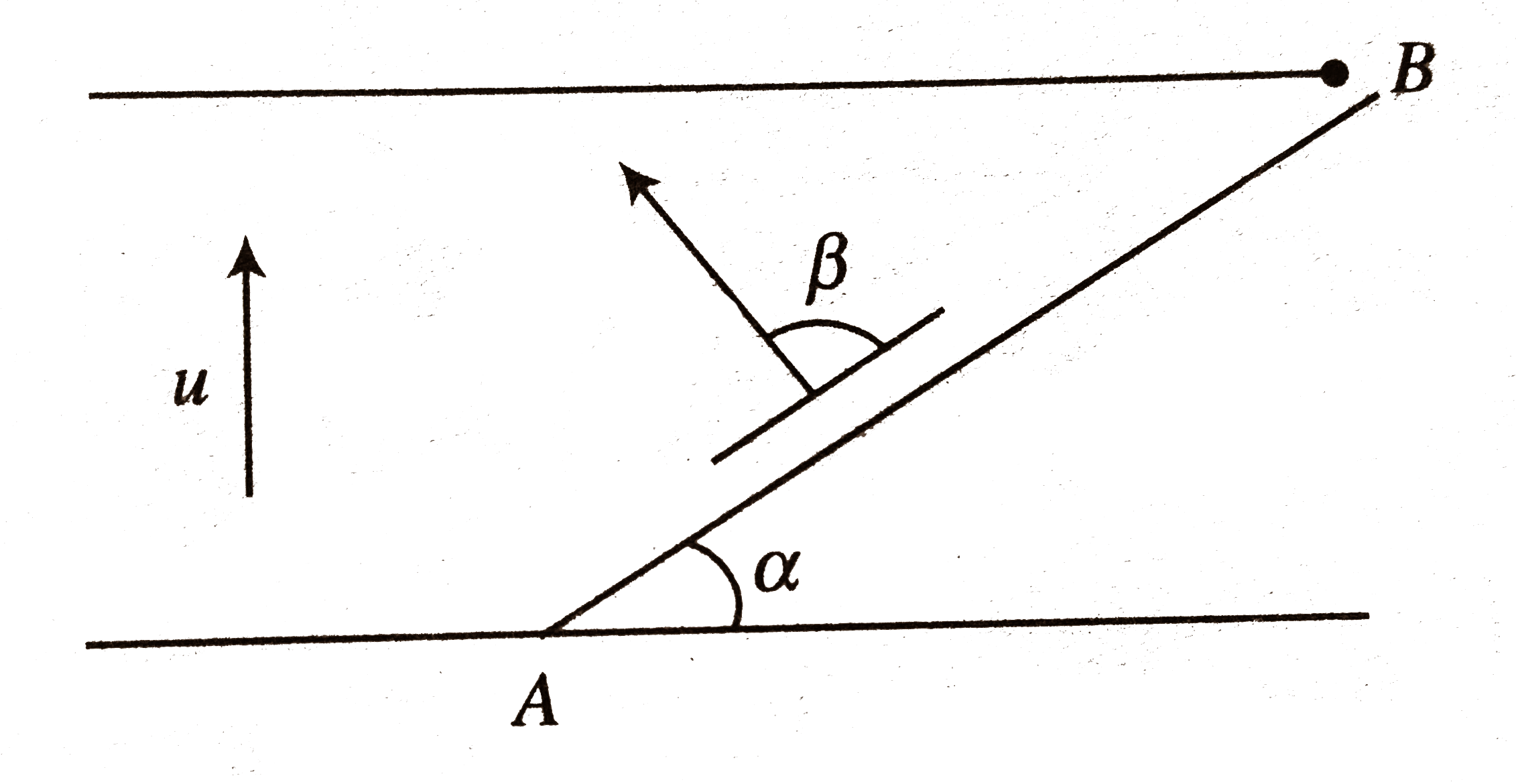 .04:32View Solution
.04:32View SolutionAn airplane is observed by two observers traveling at `60 km h^-1` in two vehicles moving in opposite directions on a straight road. To an observer in one vehicle, the plane appears to cross the road track at right angles while to the other appears to be `45^@`. At what angle does the plane actually cross the road track and what is its speed relative to ground ?
04:57View SolutionBall `I` is thrown towards a tower at an angle of `60^@` with the horizontal with unknown speed `(u)`. At the same moment, ball `II` is released from the top of tower as shown in (Fig. 5.189). Balls collide after `2 s` and at the moment of collision, the velocity of ball `I` is horizontal. Find the
(a) speed `u`
(b) distance of point of projection of ball `I` from base of tower `(x)`
( c) height of tower
 .03:56View Solution
.03:56View SolutionA ball is fired from point `P`, with an initial speed of `50 m s^-1` at an angle of `53^@`, with the horizontal. At the same time, a long wall `AB at 200 m` from point `P` starts moving toward `P` with a constant speed of `10 m s^-1`. Find
(a) the time when the ball collides with wall `AB`.
(b) the coordinate of point `C`, where the ball xollides, taking point `P` as origin.
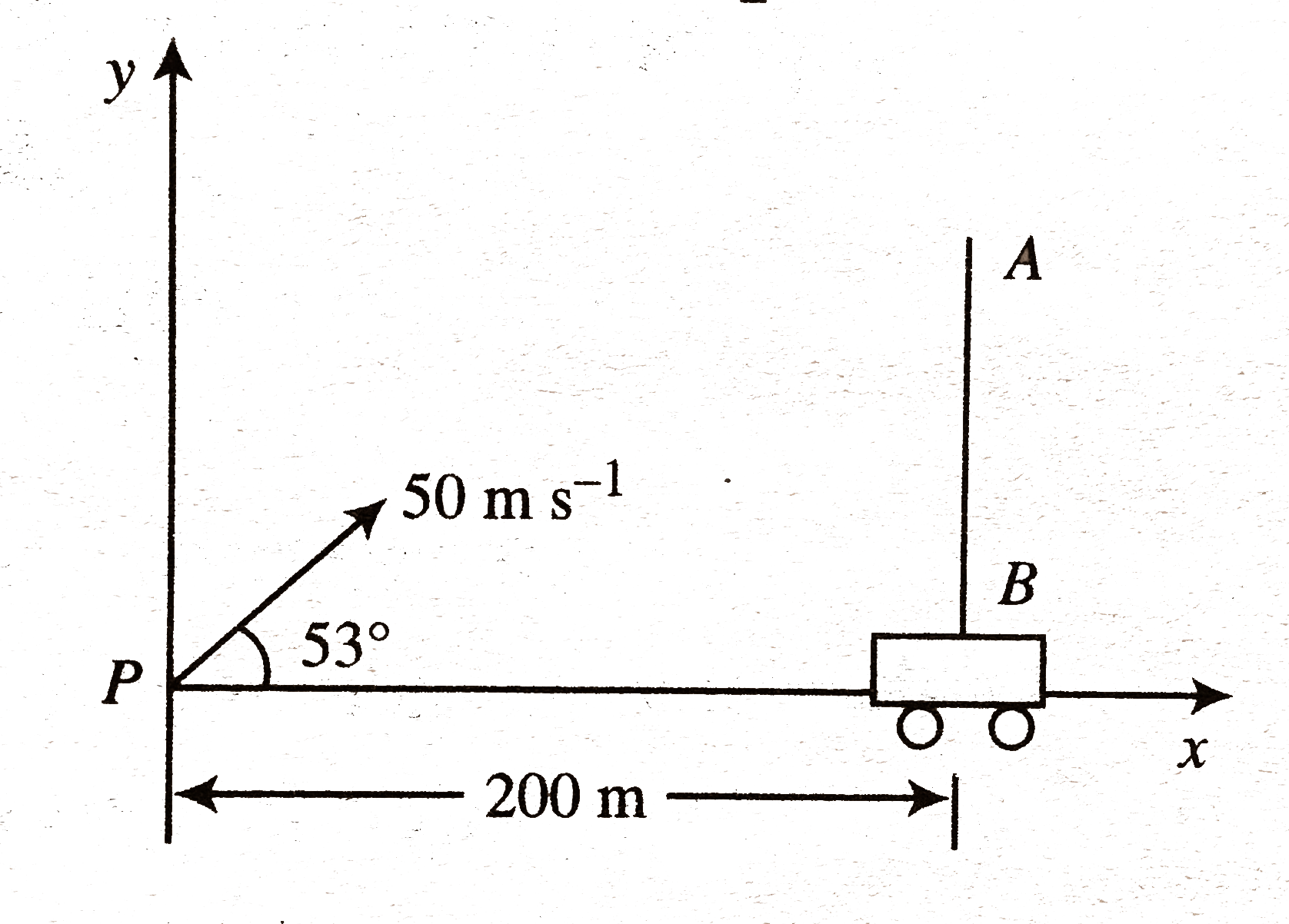 .04:45View Solution
.04:45View SolutionA rock is launched upward at `45^@`. A bee moves along the trajectory of the rock. What is the magnitude of acceleration `("in" m s^-2)` of the bee at the top point of the trajectory ? For the rock, neglect the air resistance.
02:38View SolutionA boy throws a ball with speed `u` in a well of depth `14 m` as shown in (Fig. 5.191). On bounce with the bottom of the well, the speed of the ball gets halved. What should be the minimum value of `u( "in" ms^-1)` such that the ball may be able to reach his hands again ? It is given that his hands are at `1 m` height from top of the well while throwing and catching.
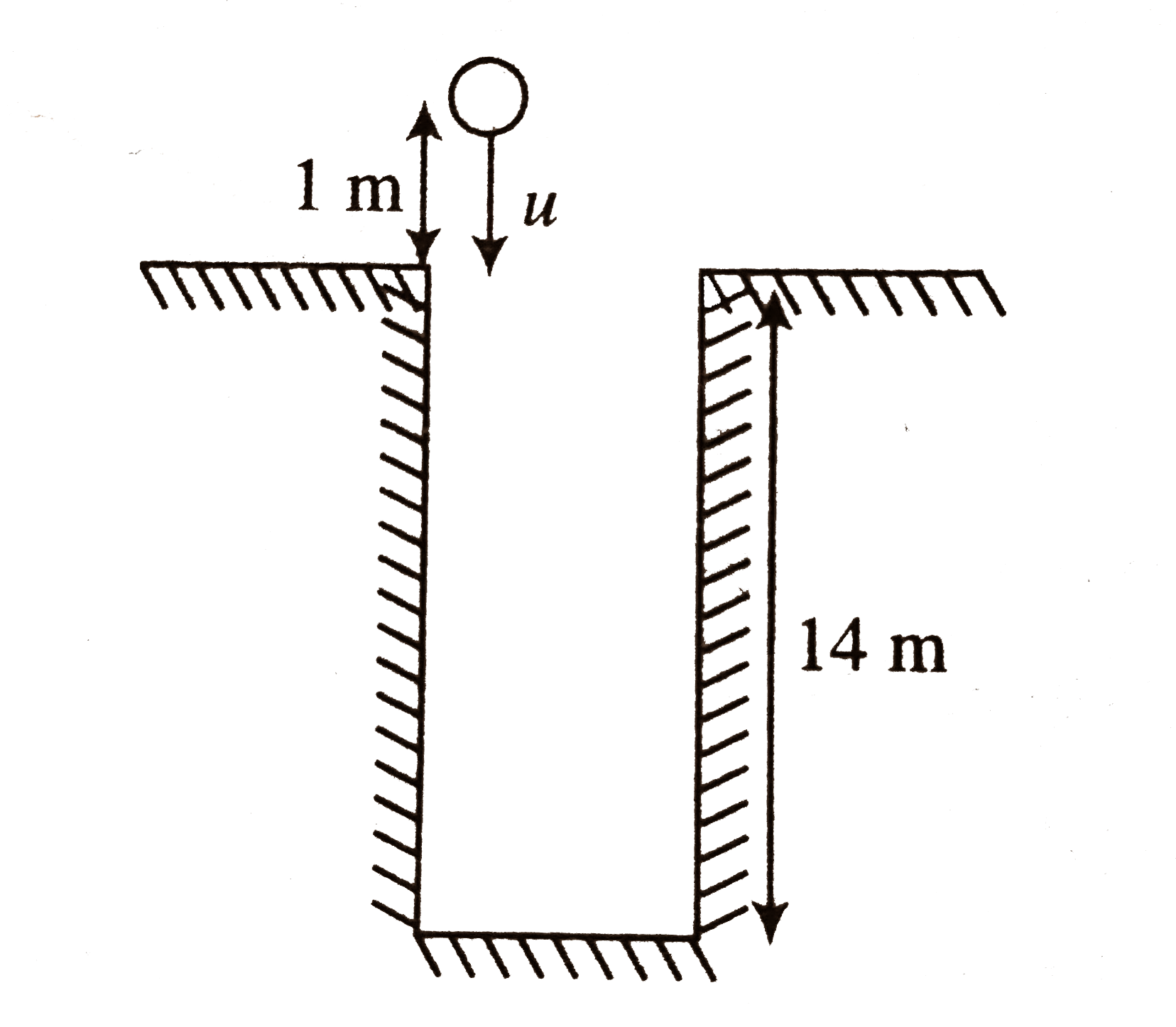 .07:00View Solution
.07:00View SolutionA helicopter is moving verticallly upwards with a velocity `5 ms^-1`. When the helicopter is at a height `10 m` from ground, a stone is thrown with a velocity `(3 hat i + 4 hat j) m s^-1` from the helicopter w.r.t. the man in it. Considering the point on ground vertically below the helicopter as the origin of coordinates, and the ground below as `xy` plane, find the coordinates of the point where the stone will fall, its distance from origin at the instant the stone strikes the ground, assuming helicopter moves upwards with constant velocity.
 .07:14View Solution
.07:14View SolutionThe direction of a projectile at a certain instant is inclined at an angle `prop` to the horizontal , after `t` second, it is inclined at an angle `beta`. Prove that the horizontal component of the velocity of the projectile is `("gt")/(tan prop - tan beta)`.
05:51View SolutionA boy on a train of height `h_1` projects a coin his friend of height `h_2` standing on the same train, with a velocity `v` relative to the train, at an angle `theta` with horizontal. If the train moves with a constant velocity `v'` in the direction of x - motion of the coin, find the
(a) distance between the boys so that the second boy can catch the coin,
(b) maximum height attained by the coin, and
( c) speed with which the second boy catches the coin relative to himself (train) and ground.07:58View SolutionTo a man going with a speed of `5 ms^-1`, rain appears to be falling vertically. If the actual speed of rain is `10 m s^-1`, then what is the angle made by rain with the vertical ?
03:01View SolutionA ship is sailing due north at a speed of `1.25 ms^-1`. The current is taking it towards east at the rate of `2 ms^-1`. and a sailor is climbing a vertical pole in the ship at the rate of `0.25 ms^-1`. Find the magnitude of the velocity of the sailor with respect to ground.
02:40View SolutionA bomber plane moves due east at `100 km h^-1` over a town `T` at a certain instant of time. Six minutes later, an interceptor plane sets off flying due north - east from the station `S` which is `40 km` south of `T`. If both maintain their courses, find the velocity with which the interceptor plane must fly in order to just overtake the bomber.
03:46View SolutionThe velocity if a swimmer `(v)` in stil water is less than the velocity of water `(u)` in a river. Show that the swimmer must aim himself at an angles `cos^-1` `(v//u)` with upstream in order to cross the river along the shortest possible path. Find thr drifting (distance moved along the direction of stream in crossing the river) of the swimmer along this shortest possible path.
05:03View SolutionA man wants to reach point B on the opposite bank of a river flowing at a speed as shown in figure. What minimum speed and in which direction should the man swim relative to water so that he can reach point B ?
 01:54View Solution
01:54View SolutionA launch plies between two points A and B on the opposite banks of a river always following the line AB. The distance S between points and B is 1200 m. The velocity of the river current `v= 1.9 m//s` is constant over the entire width of the river. The line AB makes an angle `alpha= 60^@` with the direction of the current. With what velocity u and at what angle beta to the line AB should the launch move to cover the distance AB and back in a time `t= 5 min`? The angle beta remains the same during the passage from A to B and from B to A.
 04:14View Solution
04:14View SolutionA ship `A` streams due north at `16 km h^-1` and a ship `B` due west at `12 km h^-1`. At a certain instant `B` is `10 km` north east of `A`. Find the
(a) magnitude of velocity of `A relative to B`.
(b) nearest distance of approach of ships.05:14View SolutionTwo particles start moving simultaneously with constant velocities `u_1 and u_2` as shown in (Fig. 5.194). First particle starts from `A` along `AO` and second starts from `O` along `OM`. Find the shortest distance between them during their motion.
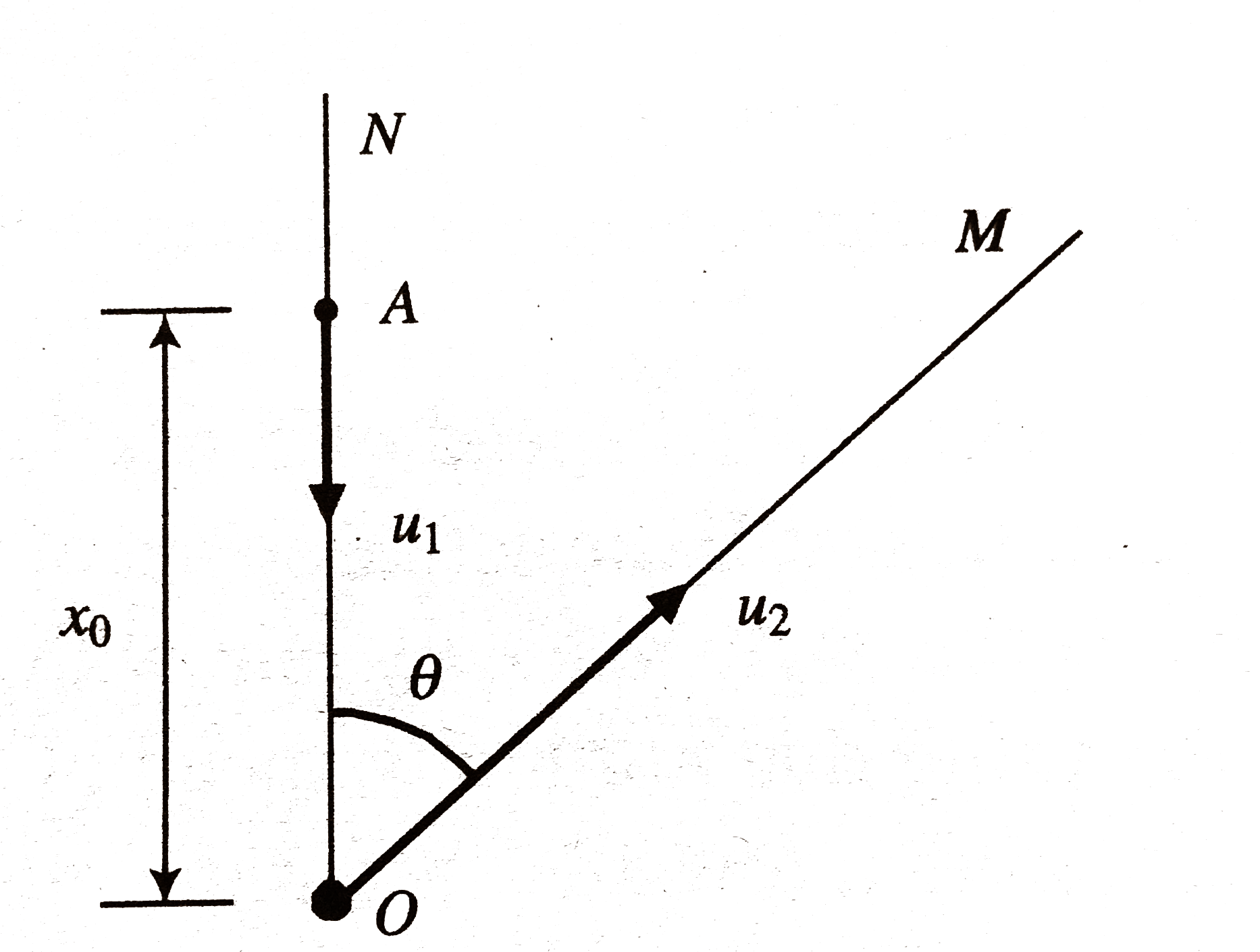 .05:59View Solution
.05:59View SolutionThe front wind screen of a car is inclined at an `60^@` with the vertical. Hailstones fall vertically downwards with a speed of `5 sqrt(3) ms^-1`. Find the speed of the car so that hailstones are bounced back by the screen in vertically upward direction with respect to car. Assume elastic collision of hailstones with wind screen.
04:44View SolutionA particle is projected from point `A` to hit an apple as shown in (Fig. 5.195). The particle is directly aimed at the apple. Show that particle will not hit the apple. Now show that if the string with which the apple is hung is cut at the time of firing the particle, then the particle will hit the apple.
 .View Solution
.View SolutionA ball is projected for maximum range with speed `20 ms^-1`. A boy is located at a distance `25 m` from point of throwing start run to catch the ball at the time when the ball was projected. Find the speed of the boy so that he can catch the ball `(Take g = 10 ms^-1)`.
03:55View SolutionA target is fixed on the top of a tower `13 m` high. A person standing at a distance of `50 m` from the pole is capable of projecting a stone with a velocity `10 sqrt(g) ms^-1`. If he wants to strike the target in shortest possible time, at what angle should he project the stone ?
06:16View SolutionA stone is projected from the ground in such a direction so as to hit a bird on the top of a telegraph post of height h and attains the maximum height of 2h above the ground. If at the insatant of projection, the bird were to fly away horizontally with a uniform speed, find the ratio between the horizontal velocity of bird and the horizontal component of velocity of stone, if the stone hits the bird while descending.
07:58View SolutionA ball rolls of the top fi a strair way with horizonntal velocity of magnitude ` 1. 8 ms^(-1)`. The steps are ` 0.20 m` high and ` 0.02 m` wide , Which step will the ball it first ? ( g = 10 m//s^@)`.
04:07View SolutionA machine gun is mounted on the top of a tower of height `h`. At what angle should the gun be inclined to cover a maximum range of firing on the ground below ? The muzzle speed of bullet is `150 ms^-1`. Take `g = 10 ms^-2`.
06:06View Solution(Figure 5.196) shows an elevator cabin, which is moving downwards with constant acceleration `a` . A particle is projected from corner `A`, directly towards diagonally opposite corner `C`. Then prove that
(a) particle will hit `C` only when `a = g`.
(b) Particle will hit the wall `CD if a lt g`.
( c) Particle will hit the roof `BC if a gt g`.
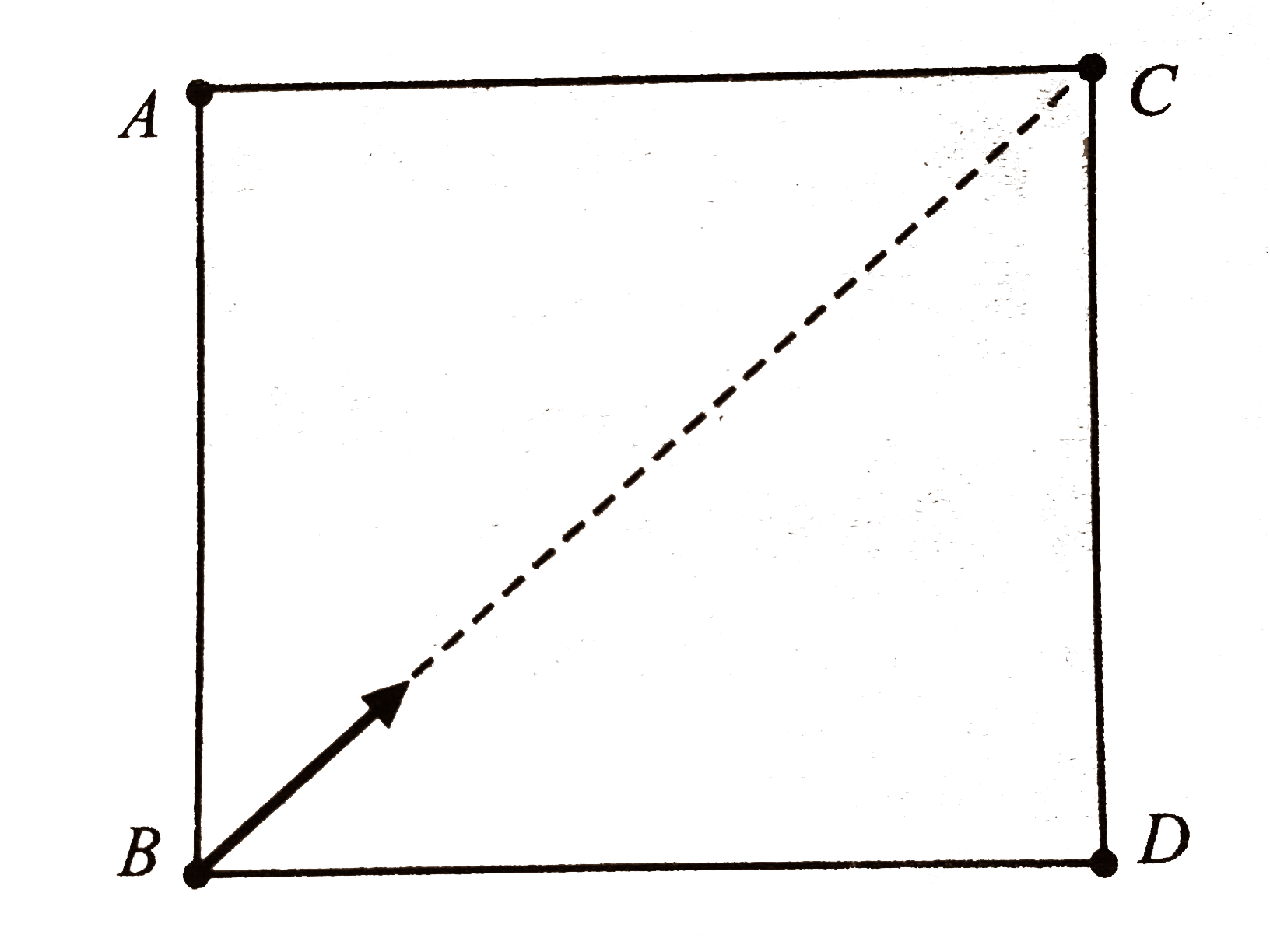 .03:09View Solution
.03:09View SolutionA ball is thrown with a velocity whose horizontal component is `12 ms^-1` from a point `15 m` above the ground and `6 m` away from a verticlewall `18.75 m` high in such a way so as just to clear the wall. At what time will it reach the ground ? `(g = 10 ms^-2)`.
06:16View SolutionA particle is projected up an inclined plane of inclination `beta` at na elevation `prop` to the horizon. Show that `tan prop = cot beta + 2 tan beta`, if the particle strikes the plane at right angles
07:56View SolutionTwo parallel straight lines are inclined to the horizon at an angle `prop`. A particle is projected from a point mid way between them so as to graze one of the lines and strikes the other at right angle. Show that if `theta` is the angle between the direction of projection and either of lines, then `tan theta = (sqrt(2 - 1)) cot prop`.
14:28View SolutionA small sphere is projected with a velocity of `3 ms^-1` in a direction `60^@` from the horizontal y - axis, on the smooth inclined plane (Fig. 5.197). The motion of sphere takes place in the x - y plane. Calculate the magnitude `v` of its velocity after `2 s`.
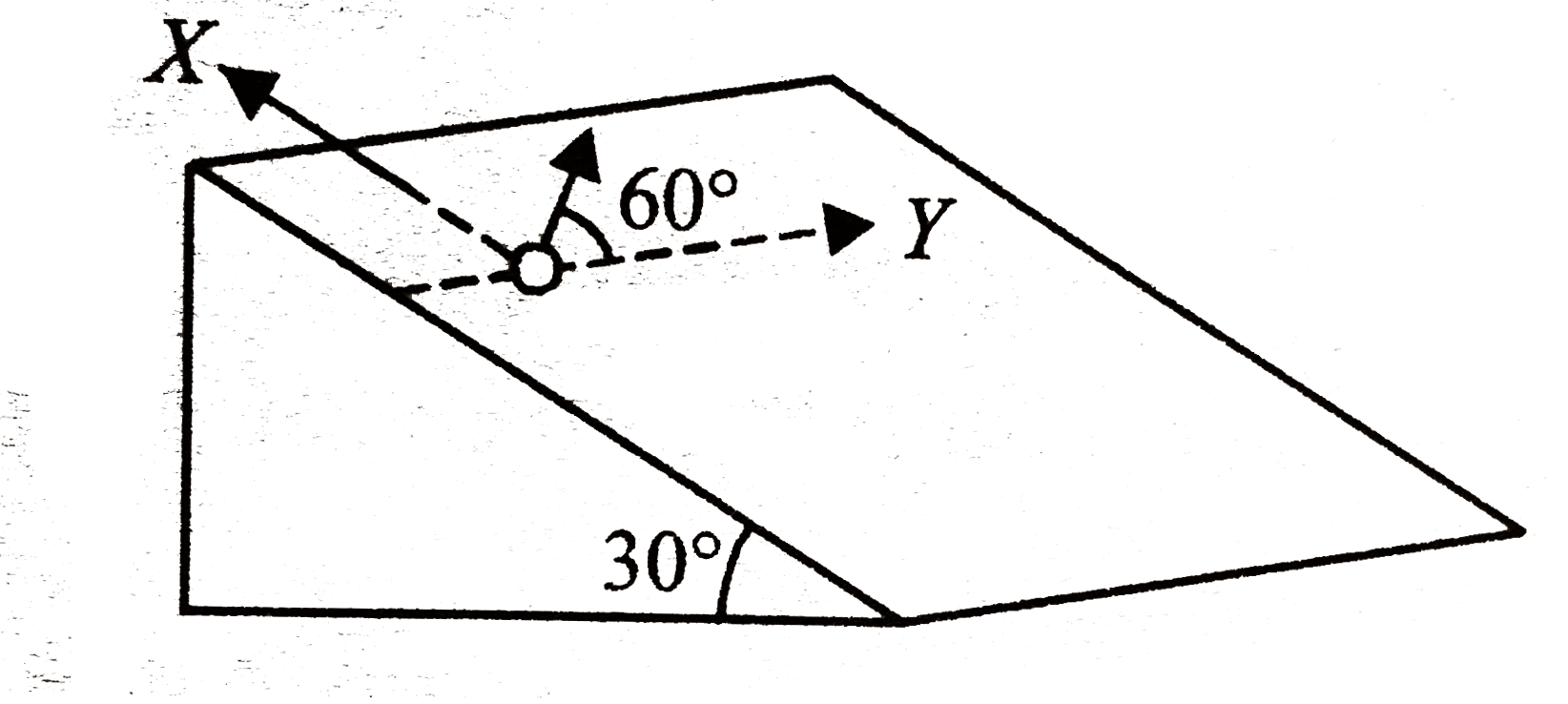 .02:43View Solution
.02:43View SolutionA gun is fired from a moving platform and ranges of the shot are observed to be `R_1 and R_2` when the platform is moving forwards and backwards, respectively, with velocity `v_P`. Find the elevation of the gun `prop` in terms of the given quantities.
04:06View SolutionA cylclist is riding with a speed of `27 km h^-1`. As he approaches a circular turn on the road of radius `80 m`, he applies brakes and reduces his speed at the constant rate of `0.5 ms^-2`. What is the magnitude and direction of the net acceleration of the cyclist on the circular turn ?
02:52View SolutionAn electric fan has blades of length `30 cm` as measured from the axis of rotation. If the fan is rotating at 1200 rpm, find the acceleration of a point on the tip of a blade.
02:40View SolutionA particle starts from rest and moves in a circular motion with constant angular acceleration of `2 rad s^-2`. Find
(a) Angular velocity
(b) Angular displacement of the particle after `4 s`.
( c) The number of revolutions completed by the particle during these `4 s`.
(d) If the radius of the circle is `10 cm`, find the magnitude and direction of net acceleration of the particle at the end of `4 s`.09:00View Solution
Exercise Subjective questions and complete solutions for chapter KINEMATICS-2 of CENGAGE PHYSICS (ENGLISH) of Class 11
